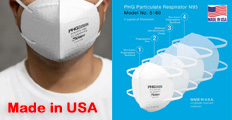



Find all of your laboratory and workplace safety supplies at Safety Emporium!
 Emetic |
 Glossary Index |
 Energy Units |
| MSDS Topics |
Free Sites | FAQ's | Regulations | Glossary | Software | Suppliers |
| Books | Forum | Poll | Fun stuff | Quiz | Store | |
| Understand your MSDS with the MS-Demystifier | Search ALL our MSDS info | |||||
Emphysema is a disease in which the alveoli (tiny air sacs) of the lung become damaged. This results in a decrease in respiratory function (the lungs don't work as well) and (often) breathlessness.
Early symptoms of emphysema include shortness of breath and cough. Emphysema and chronic bronchitis together comprise chronic obstructive pulmonary disease (COPD).
Smoking is by far the major risk factor (cause) of emphysema, accounting for 82% of COPD cases according to the American Lung Association. Certain individuals are also genetically disposed towards emphysema; this form is called alpha 1-antitrypsin (AAT) emphysema.
Extensive smoking can lead to irreparable lung damage, even if you quit smoking. In these cases, the condition is not likely to improve and death by respiratory or cardiac (heart) failure is the inevitable outcome (months to years). Is smoking worth three years on a respirator as your body wastes away? Quit today, if not for yourself then for your friends and families who don't want to deal with that.
Up to 15% of COPD cases are from occupational exposures (J Occupational Medicine and Toxicology 2006, 1:11; doi:10.1186/1745-6673-1-11). Coal miners, hard-rock miners, tunnel workers, concrete-manufacturing workers, and non-mining industrial workers have the highest risk, but any occupation involving dusts, chemicals or gases can be at risk. Those involved in such activities who smoke elevate their risk even more.
There are other medical conditions that have the word emphysema in the name, but do not necessarily involve the lungs. For example, subcutaneous emphysema occurs when air gets into the tissues under the skin covering the chest wall, neck and face as a result of blunt trauma, stab wounds, collapsed lungs, and more.
In exceedingly rare cases, subcutaneous emphysema can occur when dental patients accidentally get air shot under the skin of their face and/or neck through open dental work or anesthetic injection sites. The resulting air pockets are highly visible, and make crackling sounds that are audible only to the patient (crepitations) as they move around. While mild cases are generally harmless and resolve on their own, prophylactic (preventative) antibiotics such as oral clindamycin are a good idea to combat any oral bacteria that may have been injected. We mention it here only because this happened to one of our staff members and most dentists have never encountered the phenomenon outside of dental school.
Additional/related occupational lung diseases include asbestiosis, pneumoconiosis, and silicosis, among others.
NOTE: We may collect a share of sales or other compensation from the links in the following list:
On certain Safety Data Sheets, emphysema will appear on Section 11 (toxicological information) as a symptom of repeated exposure to substances known to cause lung damage or disease. It may also appear in the context of a condition that can be aggravated by exposure to the chemical(s) listed on the SDS.
Emphysema can be aggravated by air pollution or exposure to certain chemicals. The first action you can take to avoid emphysema is to make sure you do not inhale smoke, especially cigarette smoke. Avoid workplace exposure to chemicals that have irritating vapors or dusts.
If you work in an occupation that has a risk for COPD or emphysema, your employer needs to take steps to avoid the generation of inhalable substances in the first place. Engineering controls and ventilation methods should be used to reduce or contain the chemicals, fumes or dusts. Appropriate PPE such as respirators should be used if other methods are not sufficient to mitigate the risk.
See also: asthma, dust, dyspnea, pneumoconiosis, smoke.
Additional definitions from Google and OneLook.
Entry last updated: Sunday, July 24, 2022. This page is copyright 2000-2025 by ILPI. Unauthorized duplication or posting on other web sites is expressly prohibited. Send suggestions, comments, and new entry desires (include the URL if applicable) to us by email.
Disclaimer: The information contained herein is believed to be true and accurate, however ILPI makes no guarantees concerning the veracity of any statement. Use of any information on this page is at the reader's own risk. ILPI strongly encourages the reader to consult the appropriate local, state and federal agencies concerning the matters discussed herein.